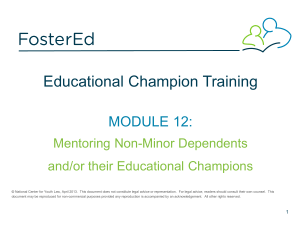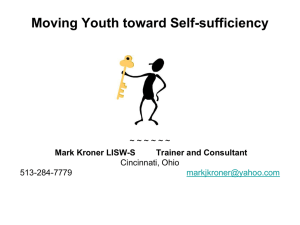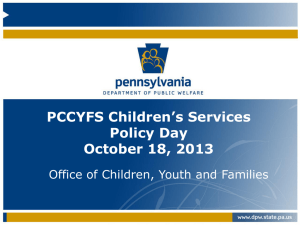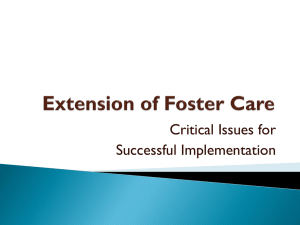Title Layout - Jim Casey Youth Opportunities Initiative
advertisement
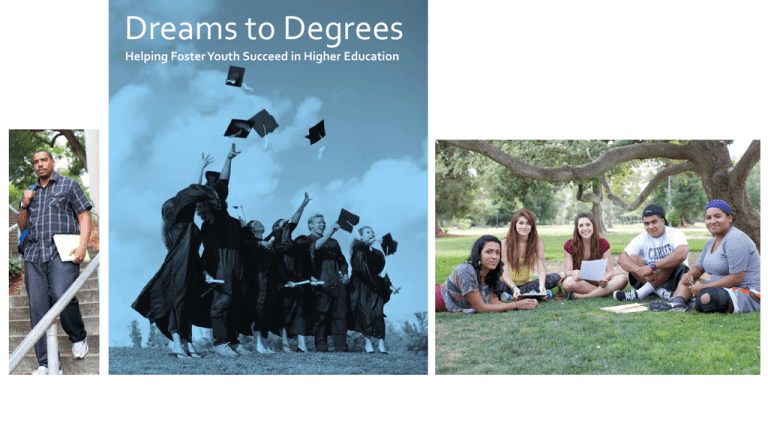
Dreams to Degrees Helping Foster Youth Succeed in Higher Education Presenters Yali Lincroft , Program Officer, Walter S. Johnson Foundation (MODERATOR) yali@childpublicpolicy.com Alexia Everett, Senior Program Officer, Stuart Foundation aeverett@stuartfoundation.org Eileen McCaffrey, Foster Care to Success, eccaffrey@fc2Success.org Celeste Bodner, FosterClub, eccaffrey@fc2Success.org George White, Youth Advocate Today’s outline • Overview: Why this work? Why foster youth? • State & Federal policy change, and how young people have been engaged in efforts • Role of youth engagement on institutional & practice change • One-to-one: engagement of individual foster youth Why this work? Why foster youth? The case for focusing efforts on the 400,000 young people in foster care, and the 30,000 youth who will age out this year Demographics From Mark Courtney’s Midwest Study (2011) • By age 26, 1 in 5 foster youth compared to 1 in 20 youth in general population have not completed high school or obtained a GED • Foster youth are 6x less likely to complete a two-or four-year college degree compared to their non-foster care peers. • By age 26, of the students enrolled in a two- or four-year college, 55% reported ever having dropped out of school. • When asked for explanation for leaving school, several themes emerged (need to work/ can’t afford tuition and fees, pregnancy, coursework problems, family emergencies) From California’s Invisible Achievement Report (2014) • In California, 43,140 students in grades K-12 and between 5-17 were in foster care during all or part of the 2009/10 school year. • Links data from the California Department of Education and the California Department of Social Services. • Offers the first statewide comprehensive educational snap-shot. Key Findings 1. Students in every type of foster care placement experienced an achievement gap compared to their peers in school. 2. Students in foster care were more likely than other students to change schools during the school year. 3. Students in foster care are more likely than the general student population to be enrolled in the lowest performing schools and more likely to be enrolled in nontraditional schools. 4. Students in foster care had the lowest participation in California’s statewide testing programs and participation was tied to placement instability. Key Findings 5. Statewide testing documented that the achievement gap for students in foster care was greatest in upper grade levels and for students who experienced 3 or more foster care placement. 6. Among all high school students, those in foster care had the highest dropout and lower graduation rates. State & Federal Policy Changes … and how young people have been involved in these efforts Federal Policies • Chafee Education & Training Voucher (ETV) Program - 2001 • College Cost Reduction Act - 2007 • Higher Education Act (HEA) – 2008 Education and Training Voucher (ETV) Administration • Different models for ETV Program administration • State administered • State Higher Education Agency • Foster Care to Success • Local Agency • ETV funding is fully expended by states. • ETV funding is tied to earning a credential. • Time-limited financial aid MUST be accompanied by student support services. Federal Policies • Fostering Connections to Success and Increasing Adoptions Act - 2008 • Uninterrupted Scholars Act (USA/FERPA amendment) - 2013 State and Local Advocacy North Carolina www.saysoinc.org Maryland - http://www.acy.org/ New York www.youthinprogress.org/ August 5, 2014 State and Local Advocacy • www.calyouthconn.org Foster Youth in Action 6 states organizing for change States Providing Tuition Waivers DISCUSSION: Lessons learned in engaging foster youth in practice and program implementation and reform WHY ENGAGE? Benefits to young leaders •Youth gain through giving back: •Cathartic •Positive peer support •Networking •Transferrable skills developed August 5, 2014 Programs & Services Education & Training for Staff Data Collection (State, Campus, and Student) Summary & More Information What We Know: College preparation is essential. •Address academic deficits in elementary and secondary schools. •High school counts – enroll in college prep programs. Nonacademic factors can derail a student’s academic career. • Family re-engagement and caretaking; Lack of affordable housing; Transportation; Parenting; and Poor money management skills. There are multiple pathways to success. • Identify options based on strengths, talents and aptitudes. Effective programs blend financial resources with academic & interpersonal supports. • Students need more than money to be successful in postsecondary programs. • Help them get involved on campus and connected to resources. August 5, 2014 For More information • FosterClub – https://www.fosterclub.com • FosterU – new website from Foster Care to Success http://www.fc2success.org/ • California College Pathways – website and newsletter http://www.cacollegepathways.org


